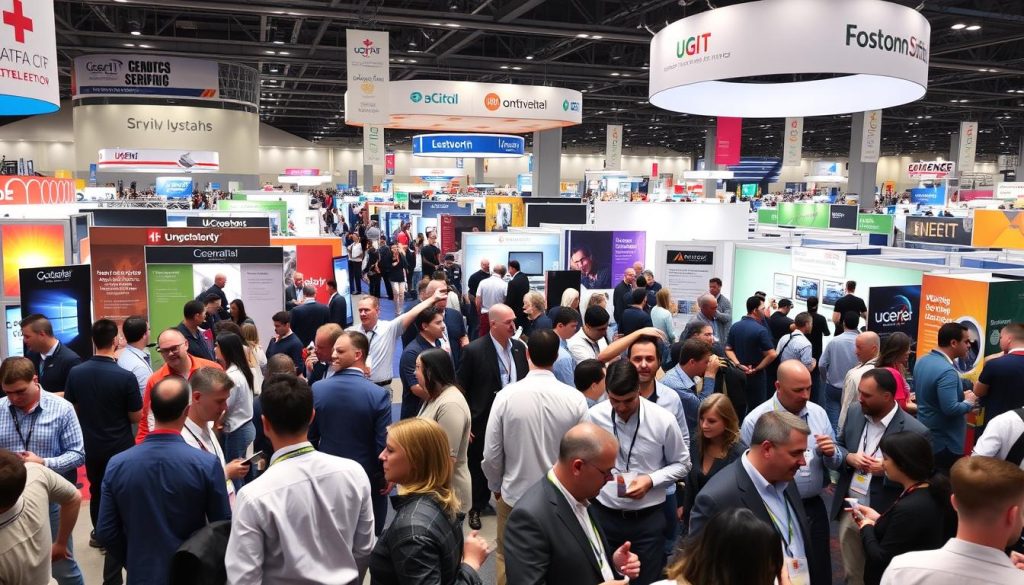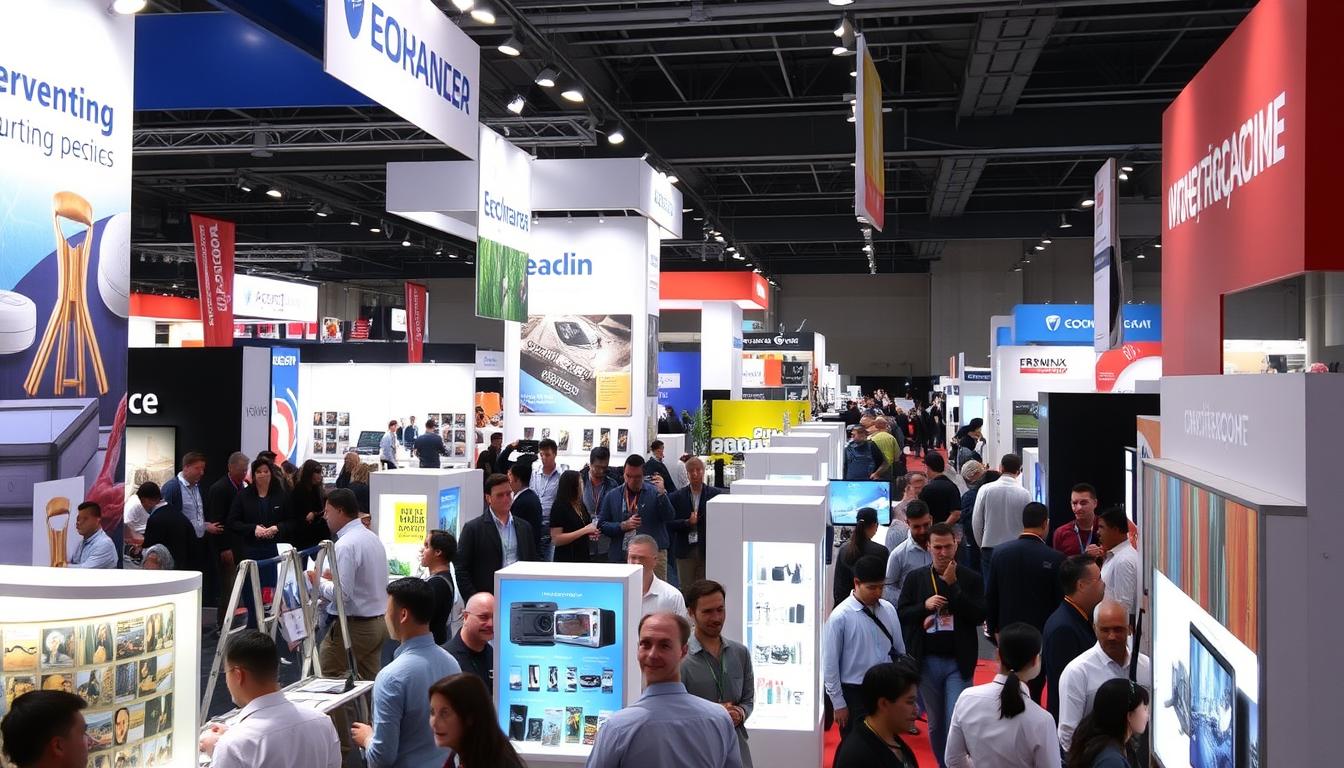Trade shows offer a unique opportunity to showcase your brand and generate valuable leads. Turning booth traffic into sales requires a strategic approach to trade show marketing. By focusing on effective lead generation and optimizing your sales pipeline, you can maximize your return on investment.
Successful conversion optimization starts with attracting the right audience to your booth. Once you’ve captured their attention, it’s crucial to engage visitors meaningfully and collect quality leads. This sets the stage for post-show follow-ups and nurturing potential customers through your sales funnel.
Key Takeaways
- Develop a targeted trade show marketing strategy
- Implement effective lead generation techniques
- Design an engaging booth to attract quality prospects
- Optimize your sales pipeline for higher conversion rates
- Follow up promptly and persistently with leads post-show
- Measure and analyze your trade show ROI
Understanding Trade Show Marketing Fundamentals
Trade show marketing forms a crucial part of many businesses’ customer acquisition strategies. By grasping the key elements of successful trade show presence, companies can maximize their event marketing tactics and boost their return on investment.
Key Components of Successful Trade Show Presence
A winning trade show strategy involves several elements. Eye-catching booth design, engaging demonstrations, and well-trained staff are essential. Interactive displays and effective lead capture systems can significantly enhance your presence. Remember, your goal is to stand out amidst a sea of competitors.
Market Research and Target Audience Analysis
Understanding your target audience is critical in trade show marketing. Conduct thorough market research to identify attendees’ needs, pain points, and preferences. This knowledge will help tailor your messaging and offerings to resonate with potential customers, increasing your chances of success.
Setting Clear Exhibition Goals and Objectives
Define specific, measurable goals for your trade show participation. These might include:
- Generating a certain number of qualified leads
- Launching a new product
- Strengthening relationships with existing clients
- Increasing brand awareness
Clear objectives will guide your event marketing tactics and help you measure your performance post-show.
“A goal without a plan is just a wish.” – Antoine de Saint-Exupéry
By mastering these trade show marketing fundamentals, you’ll be well-equipped to turn booth traffic into valuable sales opportunities.
From Booth Traffic to Sales: The Full Journey Explained
The path from booth visitor engagement to successful sales pipeline conversion is a multi-step process. Trade show success hinges on understanding this journey and optimizing each stage for maximum impact.
Attracting visitors is the first crucial step. Eye-catching displays and interactive elements draw people in. Once at your booth, staff must quickly engage visitors with targeted questions to gauge interest and qualify leads.
Lead capture comes next. Digital tools streamline this process, allowing for quick data collection and real-time lead scoring. This information guides immediate follow-up strategies and helps prioritize high-potential prospects.
Post-show follow-up is where many companies falter. A prompt, personalized approach is key. Use collected data to tailor your outreach and continue nurturing leads through multiple channels.
The final stage focuses on conversion optimization. Analyze your sales pipeline to identify bottlenecks and refine your approach. Remember, the journey from booth visitor to customer is often lengthy, requiring patience and consistent effort.
| Stage | Key Action | Impact on Sales Pipeline |
|---|---|---|
| Attraction | Engaging booth design | Increases potential lead pool |
| Engagement | Targeted conversations | Qualifies leads effectively |
| Capture | Digital lead collection | Enables efficient follow-up |
| Follow-up | Personalized outreach | Nurtures leads towards conversion |
| Conversion | Tailored sales approach | Closes deals and generates revenue |
By mastering each stage of this journey, you can transform casual booth visitors into valuable additions to your sales pipeline, maximizing your trade show ROI.
Booth Design Strategies That Attract Quality Leads
Crafting an eye-catching booth is key to successful event marketing tactics. A well-designed exhibit space can significantly boost booth visitor engagement and lead generation efforts. Let’s explore some effective strategies to make your booth a magnet for quality leads.
Visual Elements That Drive Engagement
Compelling visuals are crucial for attracting attention in a crowded trade show floor. Use bold colors, striking graphics, and clear branding to make your booth stand out. Incorporate large displays showcasing your products or services in action. Digital screens with dynamic content can also captivate passersby and draw them into your space.
Interactive Technology Integration
Leverage technology to create memorable experiences for visitors. Touch screens, virtual reality demos, and interactive product displays can engage potential leads and showcase your offerings. These tech-driven elements not only attract attention but also provide valuable opportunities for data collection and lead qualification.
Space Optimization for Visitor Flow
Design your booth layout to encourage smooth visitor flow and maximize engagement. Create distinct areas for product demonstrations, one-on-one conversations, and information gathering. Use open layouts to make your booth inviting and accessible. Strategic placement of furniture and displays can guide visitors through your space, ensuring they interact with key elements of your exhibit.
| Design Element | Impact on Lead Generation | Implementation Tips |
|---|---|---|
| Bold Graphics | Attracts attention from afar | Use high-contrast colors and large fonts |
| Interactive Displays | Increases visitor engagement | Incorporate touchscreens with product demos |
| Open Layout | Encourages more foot traffic | Minimize barriers and create wide entrances |
Effective Lead Generation Techniques at Trade Shows
Trade shows offer a golden opportunity for lead generation and customer acquisition strategies. By leveraging the right techniques, you can maximize your booth’s potential and boost conversion optimization efforts.
Digital Lead Capture Methods
Gone are the days of paper business cards. Modern trade shows demand digital solutions for lead capture. QR codes, mobile apps, and badge scanners streamline the process, allowing for quick and efficient data collection. These tools integrate seamlessly with your CRM, ensuring no lead falls through the cracks.

Qualification Process During Conversations
Engaging booth visitors in meaningful conversations is crucial for lead qualification. Train your team to ask targeted questions that reveal a prospect’s needs, budget, and decision-making authority. This approach helps identify high-quality leads and tailor follow-up strategies accordingly.
Real-Time Lead Scoring Systems
Implement a real-time lead scoring system to prioritize your follow-ups. Assign points based on criteria such as company size, purchase intent, and engagement level. This enables your sales team to focus on the most promising leads immediately after the show.
| Lead Scoring Criteria | Point Value | Follow-up Priority |
|---|---|---|
| Budget Confirmed | 30 | High |
| Decision Maker | 25 | High |
| Product Demo Requested | 20 | Medium |
| Email Provided | 10 | Low |
By combining these techniques, you’ll transform your trade show presence into a powerful lead generation machine, driving sales and enhancing your overall marketing strategy.
Converting Booth Visitors into Sales Pipeline Opportunities
Trade shows offer a unique chance to fill your sales pipeline with quality leads. The key lies in turning those brief booth interactions into lasting business relationships. Let’s explore effective strategies for conversion optimization and customer acquisition at trade shows.
Start by qualifying leads right at your booth. Ask targeted questions to gauge interest and need. This helps you focus on prospects most likely to convert. Use digital tools to capture lead information quickly and accurately. This data forms the foundation of your post-show follow-up efforts.
Create a sense of urgency by offering show-specific deals or limited-time promotions. This can prompt visitors to take immediate action, accelerating their journey through your sales pipeline. Remember, the goal is to move leads from initial interest to serious consideration.
“The fortune is in the follow-up. Your post-show strategy can make or break your trade show ROI.”
After the show, segment your leads based on interest level and potential value. Tailor your follow-up communications accordingly. Quick response times are crucial – aim to reach out within 48 hours of the event. Use a mix of email, phone calls, and personalized content to nurture leads and keep your company top-of-mind.
| Lead Type | Follow-up Strategy | Expected Conversion Rate |
|---|---|---|
| Hot Leads | Immediate personal call, tailored proposal | 30-40% |
| Warm Leads | Email series, scheduled demo | 15-25% |
| Cool Leads | Newsletter subscription, educational content | 5-10% |
By implementing these customer acquisition strategies, you’ll transform more booth visitors into valuable additions to your sales pipeline. Remember, consistency and persistence are key to maximizing your trade show investment.
Post-Show Follow-Up Best Practices
Effective post-show follow-up is crucial for turning trade show leads into valuable additions to your sales pipeline. By implementing smart customer acquisition strategies, you can maximize the return on your trade show investment.
Timing and Sequence of Follow-Up Communications
Quick action is key in post-show follow-up. Reach out to leads within 24-48 hours after the event. Start with a personalized email thanking them for visiting your booth. Follow up with a phone call a few days later to schedule a more in-depth conversation.
Personalization Strategies
Tailor your follow-up messages to each lead’s specific interests and needs. Reference conversations from the trade show and highlight relevant products or services. Use their name and company information to create a personal connection.
Multi-Channel Approach to Nurturing Leads
Engage leads through various channels to keep your brand top-of-mind. Combine email, phone calls, social media outreach, and direct mail to create a comprehensive nurturing strategy. This multi-channel approach helps move leads through your sales pipeline more effectively.
| Follow-Up Channel | Timing | Purpose |
|---|---|---|
| Within 24 hours | Thank you and initial recap | |
| Phone Call | 2-3 days after email | Schedule detailed discussion |
| Social Media | 1 week after show | Share relevant content |
| Direct Mail | 2 weeks after show | Send personalized offer |

By following these post-show follow-up best practices, you can effectively nurture leads and convert them into valuable customers. Remember, consistency and personalization are key to successful customer acquisition strategies and building a robust sales pipeline.
Measuring Trade Show ROI and Sales Impact
Tracking the success of your trade show efforts is crucial for optimizing future strategies. ROI measurement helps you understand the value of your investment and guides decision-making for future events.
Key Performance Indicators (KPIs)
To gauge trade show success, focus on these KPIs:
- Booth traffic
- Leads generated
- Conversion rates
- Sales pipeline growth
Track these metrics to assess your performance and identify areas for improvement. Maximizing your product page can also boost post-show conversions.
Sales Attribution Models
Use attribution models to link sales to specific trade show interactions. This helps you understand which aspects of your booth strategy contribute most to your sales pipeline.
Long-Term Value Assessment
Look beyond immediate sales to evaluate long-term benefits:
- Brand awareness growth
- New partnerships formed
- Market intelligence gathered
These factors contribute to your overall ROI and help justify future trade show investments. Remember, conversion optimization is an ongoing process that extends well beyond the event itself.
“Trade shows are not just about immediate sales, but about building relationships that fuel your sales pipeline for years to come.”
By focusing on comprehensive ROI measurement, you’ll gain valuable insights to refine your trade show strategy and maximize your return on investment.
Building a Sustainable Trade Show to Sales Process
Creating a lasting trade show marketing strategy is key to long-term success. By fine-tuning your approach, you’ll turn booth visits into solid sales leads. This process involves using data to make smart choices and linking your trade show efforts with your overall marketing plans.
To build a strong customer acquisition strategy, start by looking at what worked well at past events. Use this info to improve your booth design, staff training, and follow-up methods. Keep track of which leads turn into sales to spot trends and boost your ROI measurement accuracy.
Remember, trade shows are just one part of your sales funnel. Make sure your trade show tactics fit well with your other marketing moves. This could mean using the same messaging across all channels or sharing trade show data with your sales team. By creating a smooth process from booth to sale, you’ll see better results and higher ROI from your trade show investments.






